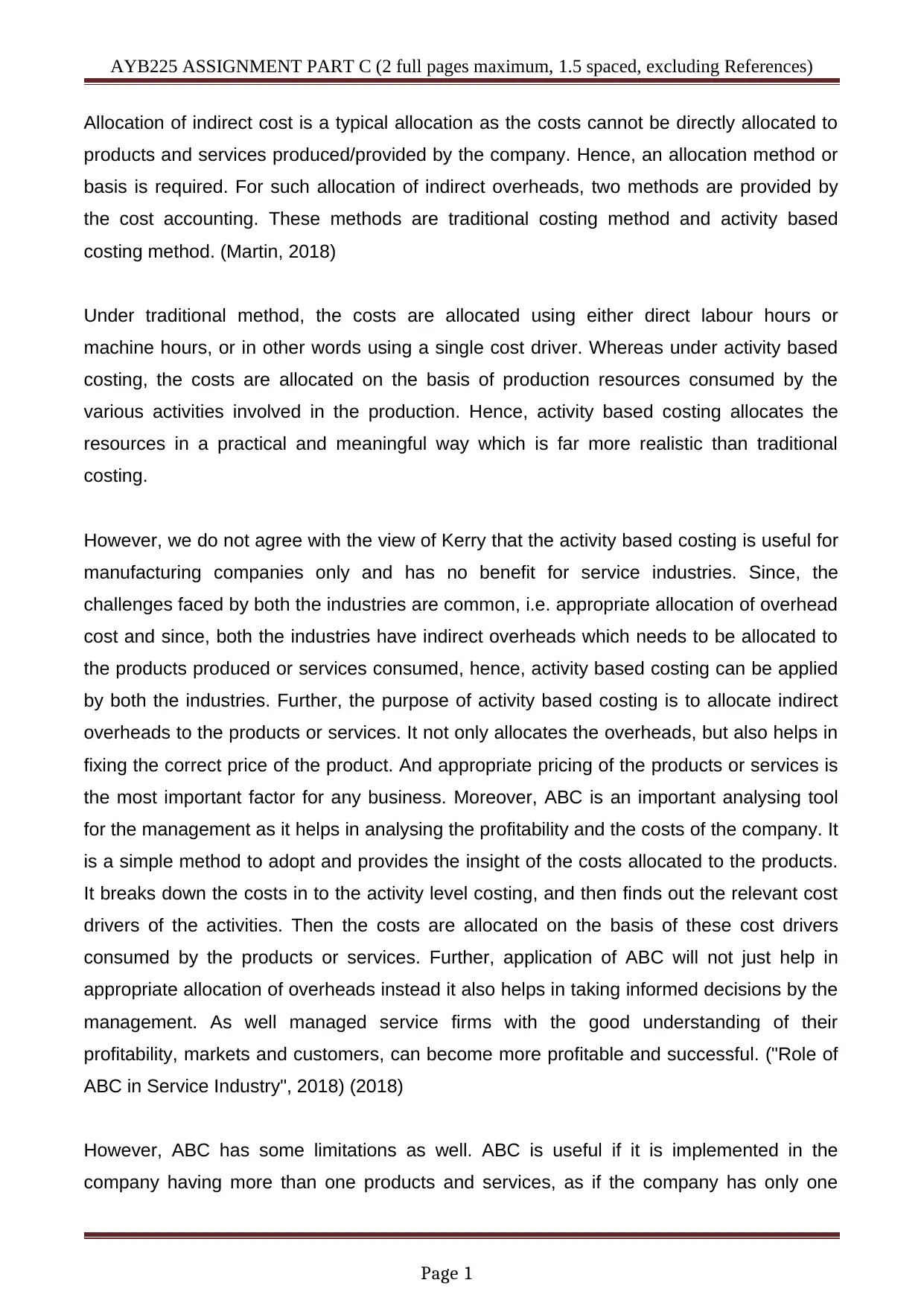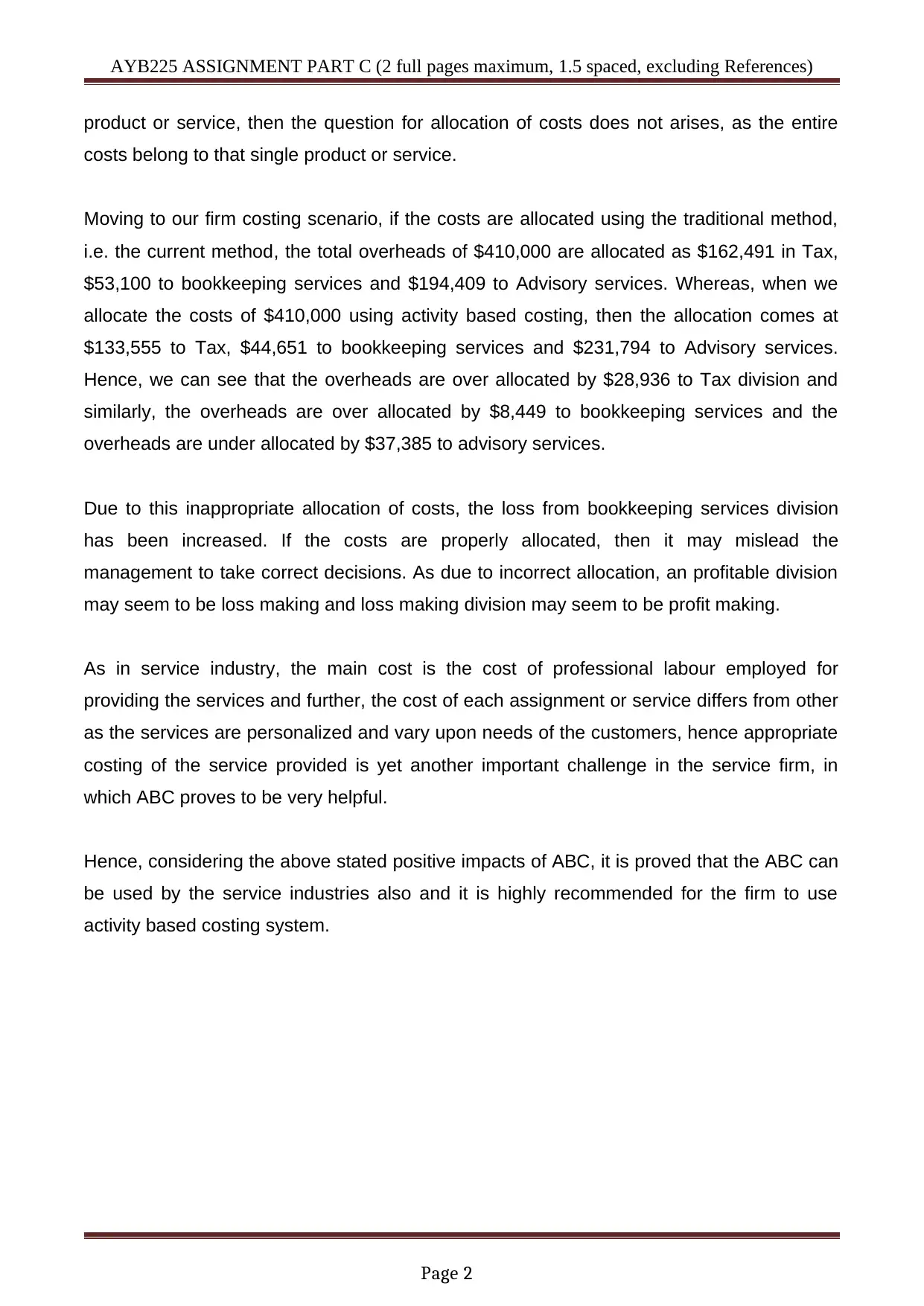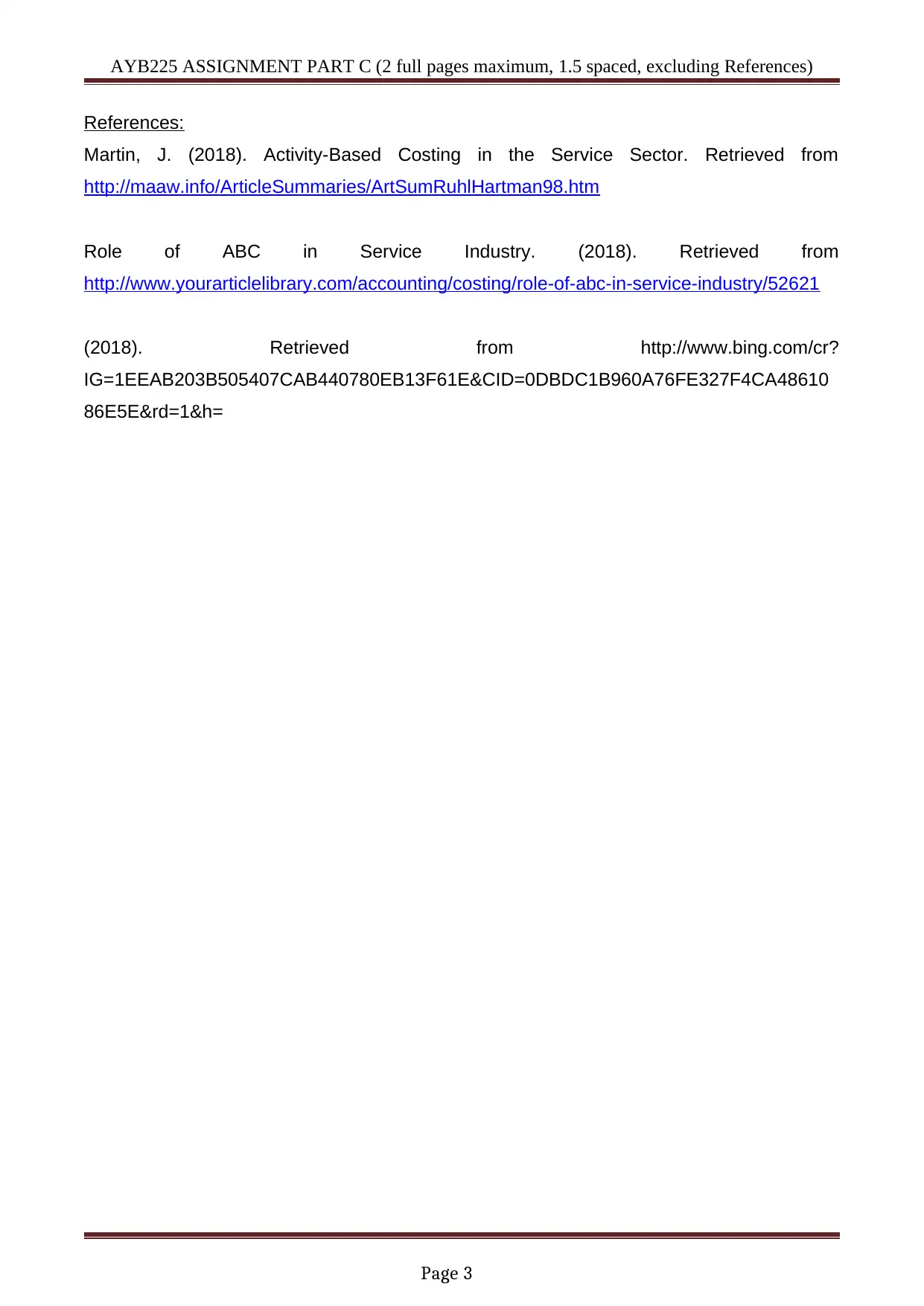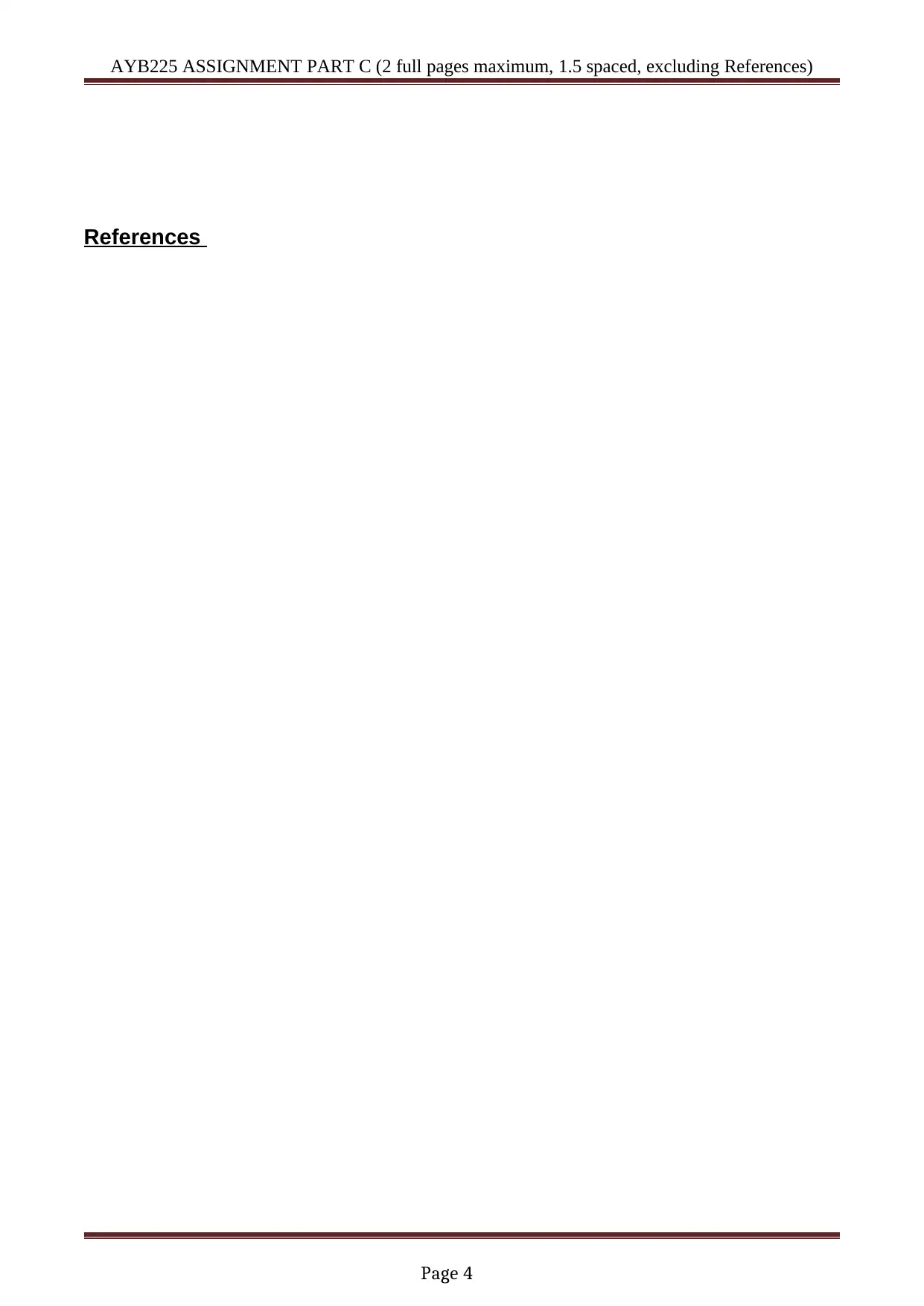Indirect Cost Allocation Methods: AYB225 Assignment Part C Report
VerifiedAdded on 2021/06/14
|4
|873
|21
Report
AI Summary
This report analyzes indirect cost allocation, comparing traditional and activity-based costing (ABC) methods. It critiques the view that ABC is only useful for manufacturing, arguing its applicability and benefits for service industries as well. The report highlights how ABC provides a more accurate allocation of overhead costs, leading to better pricing and management decisions. It presents a scenario where a firm's costs are allocated using both methods, showing how ABC can correct over and under-allocation, leading to more informed decisions. The report concludes that ABC is highly recommended for service industries, emphasizing its potential to improve profitability through accurate cost analysis and informed decision-making, as well as the importance of correct cost allocation for the services provided.

AYB225 ASSIGNMENT PART C (2 full pages maximum, 1.5 spaced, excluding References)
Allocation of indirect cost is a typical allocation as the costs cannot be directly allocated to
products and services produced/provided by the company. Hence, an allocation method or
basis is required. For such allocation of indirect overheads, two methods are provided by
the cost accounting. These methods are traditional costing method and activity based
costing method. (Martin, 2018)
Under traditional method, the costs are allocated using either direct labour hours or
machine hours, or in other words using a single cost driver. Whereas under activity based
costing, the costs are allocated on the basis of production resources consumed by the
various activities involved in the production. Hence, activity based costing allocates the
resources in a practical and meaningful way which is far more realistic than traditional
costing.
However, we do not agree with the view of Kerry that the activity based costing is useful for
manufacturing companies only and has no benefit for service industries. Since, the
challenges faced by both the industries are common, i.e. appropriate allocation of overhead
cost and since, both the industries have indirect overheads which needs to be allocated to
the products produced or services consumed, hence, activity based costing can be applied
by both the industries. Further, the purpose of activity based costing is to allocate indirect
overheads to the products or services. It not only allocates the overheads, but also helps in
fixing the correct price of the product. And appropriate pricing of the products or services is
the most important factor for any business. Moreover, ABC is an important analysing tool
for the management as it helps in analysing the profitability and the costs of the company. It
is a simple method to adopt and provides the insight of the costs allocated to the products.
It breaks down the costs in to the activity level costing, and then finds out the relevant cost
drivers of the activities. Then the costs are allocated on the basis of these cost drivers
consumed by the products or services. Further, application of ABC will not just help in
appropriate allocation of overheads instead it also helps in taking informed decisions by the
management. As well managed service firms with the good understanding of their
profitability, markets and customers, can become more profitable and successful. ("Role of
ABC in Service Industry", 2018) (2018)
However, ABC has some limitations as well. ABC is useful if it is implemented in the
company having more than one products and services, as if the company has only one
Page 1
Allocation of indirect cost is a typical allocation as the costs cannot be directly allocated to
products and services produced/provided by the company. Hence, an allocation method or
basis is required. For such allocation of indirect overheads, two methods are provided by
the cost accounting. These methods are traditional costing method and activity based
costing method. (Martin, 2018)
Under traditional method, the costs are allocated using either direct labour hours or
machine hours, or in other words using a single cost driver. Whereas under activity based
costing, the costs are allocated on the basis of production resources consumed by the
various activities involved in the production. Hence, activity based costing allocates the
resources in a practical and meaningful way which is far more realistic than traditional
costing.
However, we do not agree with the view of Kerry that the activity based costing is useful for
manufacturing companies only and has no benefit for service industries. Since, the
challenges faced by both the industries are common, i.e. appropriate allocation of overhead
cost and since, both the industries have indirect overheads which needs to be allocated to
the products produced or services consumed, hence, activity based costing can be applied
by both the industries. Further, the purpose of activity based costing is to allocate indirect
overheads to the products or services. It not only allocates the overheads, but also helps in
fixing the correct price of the product. And appropriate pricing of the products or services is
the most important factor for any business. Moreover, ABC is an important analysing tool
for the management as it helps in analysing the profitability and the costs of the company. It
is a simple method to adopt and provides the insight of the costs allocated to the products.
It breaks down the costs in to the activity level costing, and then finds out the relevant cost
drivers of the activities. Then the costs are allocated on the basis of these cost drivers
consumed by the products or services. Further, application of ABC will not just help in
appropriate allocation of overheads instead it also helps in taking informed decisions by the
management. As well managed service firms with the good understanding of their
profitability, markets and customers, can become more profitable and successful. ("Role of
ABC in Service Industry", 2018) (2018)
However, ABC has some limitations as well. ABC is useful if it is implemented in the
company having more than one products and services, as if the company has only one
Page 1
Paraphrase This Document
Need a fresh take? Get an instant paraphrase of this document with our AI Paraphraser

AYB225 ASSIGNMENT PART C (2 full pages maximum, 1.5 spaced, excluding References)
product or service, then the question for allocation of costs does not arises, as the entire
costs belong to that single product or service.
Moving to our firm costing scenario, if the costs are allocated using the traditional method,
i.e. the current method, the total overheads of $410,000 are allocated as $162,491 in Tax,
$53,100 to bookkeeping services and $194,409 to Advisory services. Whereas, when we
allocate the costs of $410,000 using activity based costing, then the allocation comes at
$133,555 to Tax, $44,651 to bookkeeping services and $231,794 to Advisory services.
Hence, we can see that the overheads are over allocated by $28,936 to Tax division and
similarly, the overheads are over allocated by $8,449 to bookkeeping services and the
overheads are under allocated by $37,385 to advisory services.
Due to this inappropriate allocation of costs, the loss from bookkeeping services division
has been increased. If the costs are properly allocated, then it may mislead the
management to take correct decisions. As due to incorrect allocation, an profitable division
may seem to be loss making and loss making division may seem to be profit making.
As in service industry, the main cost is the cost of professional labour employed for
providing the services and further, the cost of each assignment or service differs from other
as the services are personalized and vary upon needs of the customers, hence appropriate
costing of the service provided is yet another important challenge in the service firm, in
which ABC proves to be very helpful.
Hence, considering the above stated positive impacts of ABC, it is proved that the ABC can
be used by the service industries also and it is highly recommended for the firm to use
activity based costing system.
Page 2
product or service, then the question for allocation of costs does not arises, as the entire
costs belong to that single product or service.
Moving to our firm costing scenario, if the costs are allocated using the traditional method,
i.e. the current method, the total overheads of $410,000 are allocated as $162,491 in Tax,
$53,100 to bookkeeping services and $194,409 to Advisory services. Whereas, when we
allocate the costs of $410,000 using activity based costing, then the allocation comes at
$133,555 to Tax, $44,651 to bookkeeping services and $231,794 to Advisory services.
Hence, we can see that the overheads are over allocated by $28,936 to Tax division and
similarly, the overheads are over allocated by $8,449 to bookkeeping services and the
overheads are under allocated by $37,385 to advisory services.
Due to this inappropriate allocation of costs, the loss from bookkeeping services division
has been increased. If the costs are properly allocated, then it may mislead the
management to take correct decisions. As due to incorrect allocation, an profitable division
may seem to be loss making and loss making division may seem to be profit making.
As in service industry, the main cost is the cost of professional labour employed for
providing the services and further, the cost of each assignment or service differs from other
as the services are personalized and vary upon needs of the customers, hence appropriate
costing of the service provided is yet another important challenge in the service firm, in
which ABC proves to be very helpful.
Hence, considering the above stated positive impacts of ABC, it is proved that the ABC can
be used by the service industries also and it is highly recommended for the firm to use
activity based costing system.
Page 2

AYB225 ASSIGNMENT PART C (2 full pages maximum, 1.5 spaced, excluding References)
References:
Martin, J. (2018). Activity-Based Costing in the Service Sector. Retrieved from
http://maaw.info/ArticleSummaries/ArtSumRuhlHartman98.htm
Role of ABC in Service Industry. (2018). Retrieved from
http://www.yourarticlelibrary.com/accounting/costing/role-of-abc-in-service-industry/52621
(2018). Retrieved from http://www.bing.com/cr?
IG=1EEAB203B505407CAB440780EB13F61E&CID=0DBDC1B960A76FE327F4CA48610
86E5E&rd=1&h=
Page 3
References:
Martin, J. (2018). Activity-Based Costing in the Service Sector. Retrieved from
http://maaw.info/ArticleSummaries/ArtSumRuhlHartman98.htm
Role of ABC in Service Industry. (2018). Retrieved from
http://www.yourarticlelibrary.com/accounting/costing/role-of-abc-in-service-industry/52621
(2018). Retrieved from http://www.bing.com/cr?
IG=1EEAB203B505407CAB440780EB13F61E&CID=0DBDC1B960A76FE327F4CA48610
86E5E&rd=1&h=
Page 3
⊘ This is a preview!⊘
Do you want full access?
Subscribe today to unlock all pages.

Trusted by 1+ million students worldwide

AYB225 ASSIGNMENT PART C (2 full pages maximum, 1.5 spaced, excluding References)
References
Page 4
References
Page 4
1 out of 4
Related Documents
Your All-in-One AI-Powered Toolkit for Academic Success.
+13062052269
info@desklib.com
Available 24*7 on WhatsApp / Email
![[object Object]](/_next/static/media/star-bottom.7253800d.svg)
Unlock your academic potential
Copyright © 2020–2025 A2Z Services. All Rights Reserved. Developed and managed by ZUCOL.




